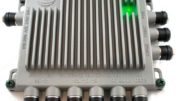If you’re looking for the ultimate cellular meter, look no further than Wilson’s CellLinq meter, pictured above. Unlike older meters, it’s a sleek module that connects to your phone over Bluetooth. From there, the free app lets you get a massive amount of data about the cell sites around you. In addition to signal, you’ll get location of nearby cell towers and even the carriers that are being received. It’s miles ahead of practically anything else.
But will it do 5G? Obviously that’s the big question for 2022 and beyond. Let’s dig in.
What you need to know about 5G and measuring signal
There are plenty of other resources on this blog about 5G. You can read them if you have some time to kill. So I’ll just go over two things you need to know if you’re going to be using a meter to measure 5G signals.
The kinds of 5G signals
Like other cellular signals, 5G broadcasts take place in different parts of the electromagnetic spectrum. There are about 5 different frequency ranges used for 3G, 4G, and LTE. (Some carriers also use other ranges, but for the most part there are 5.) One of those ranges of frequencies is also used for 5G. We call that “nationwide 5G” because it’s available in more places than any other type of 5G. However, there are two other ranges that 5G uses as well, and any meter claiming to completely measure 5G would need to measure all of them.
Mid-band 5G is in the 3-6GHz range, while Millimeter-wave 5G is in the 26-40GHz range. And right off the bat I will tell you that traditional cell meters can’t receive those signals.
The two ways signals are measured
There are two different ways to measure cell signals. You can use one, or both, and they’ll tell you different things. There’s RSSI, which is a measure of raw signal strength, and RSRP which is a measure of usable signal strength.
Much like signal-to-noise ratio with television signals, RSRP offers a view into the actual signal that’s being sent. That signal is decoded so that you get an idea how your phone is going to use signals. The Cell Linq meter is the only one that measures RSRP for 3G, 4G, and LTE. But again, I need to be upfront here, there is no meter today as I write this article that does RSRP for 5G.
Getting down to the answer
So here’s the answer you’ve waited for. The Cell Linq meter will measure “nationwide 5G” signals in RSSI mode because those signals are in the same frequency range as 3G and 4G signals. However the meter does not measure mid-band or millimeter wave signals.
That’s going to change in the future. I expect that by the end of the year there will be a version of the Cell Linq meter that measures more bands and will be able to give you an RSRP measurement for 5G signals. However, it’s expected to be more expensive and there won’t be an easy upgrade path since you’ll need new hardware.
At this moment in time, measuring RSRP for 4G and LTE is still the most important thing. Wilson and other partners are just starting to roll out cellular signal boosters for mid-band and millimeter-wave 5G. Those systems won’t be in wide distribution for quite some time.
Remember, the purpose of a cellular meter is to help you in the installation of a cell phone signal booster. Since today’s cell phone signal boosters will only handle 3G, 4G, LTE, and nationwide 5G, measuring those frequencies is all you’ll need. In the future when 5G boosters are more common, you’ll probably be ready for that upgrade anyway.
Questions?
Call the experts at Solid Signal! We’re happy to explain more and help you find the equipment you need! Our Michigan offices are open during East Coast business hours. We’re here for you at 888-233-7563.





